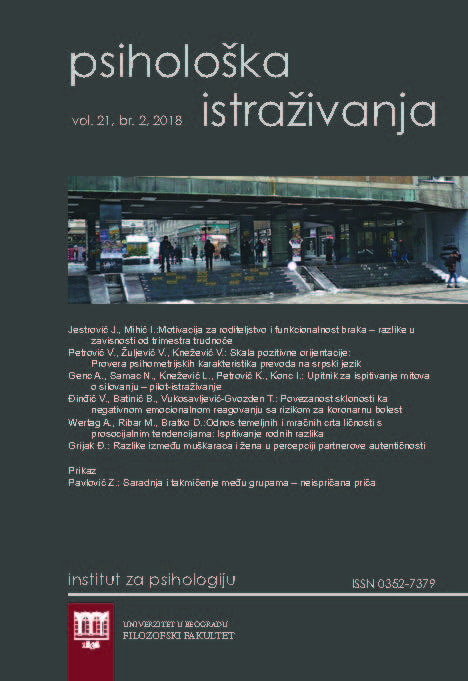DIfferences between men and women in the perception of partner's authenticity
Abstract
The research was conducted to determine whether there were differences in the perception of partner’s authenticity depending on the respondents’ gender and age, the length of marriage, satisfaction with the relationship and satisfaction with the support of the partner. Respondents were 32 married couples (N=64), with the average age of 40 years. The length of marriage of the respondents ranged from 4 to 33 years. The Authenticity in Relationships Scale (Grijak, 2018) was used in the research.The results showed no statistically significant differences between men and women in the perception of partner’s authenticity. However, there were differences in the perception of partner’s authenticity with respect to the satisfaction with the relationship in men, as well as with respect to the age of women. The men who are more satisfied with the relationship with their partner and the women aged between 41 and 49 perceive their partners as more authentic.The presented research is a significant contribution to a more detailed interpersonal examination of authenticity and the goals of partners in a relationship.
References
Brunell, A.B., Kernis, M.H., Goldman, B.M., Heppner, W., Davis, P., Cascio, E.V., i Webster, G.D. (2010). Dispositional authenticity and romantic relationship functioning. Personality and Individual Differences, 48(8), 900−905. doi:10.1016/j.paid.2010.02.018
Cole, T. (2001). Lying to the One you Love: The Use of Deception in Romantic Relationships. Journal of Social and Personal Relationships, 18(1), 107−129.doi:10.1177/0265407501181005
Cutrona, C.E., Russell, D.W., i Gardner, K.A. (2005).The Relationship Enhancement Model of Social Support.U T.A. Revenson, K. Kayser, i G. Bodenmann (Ur.), Decade of behavior. Couples coping with stress: Emerging perspectives on dyadic coping.(str. 73−95). Washington: American Psychological Association (APA). doi:10.1037/11031-004
DePaulo, B.M., i Kashy, D.A. (1998). Everyday lies in close and casual relationships. Journal of Personality and Social Psychology, 74(1), 63−79. doi:10.1037//0022-3514.74.1.63
Fincham, F.D., i Bradbury, T.N. (1992).Assessing attributions in marriage: The Relationship Attribution Measure. Journal of Personality and Social Psychology, 62(3), 457−468. doi:10.1037//0022-3514.62.3.457
Grégoire, S., Baron, L., Ménard, J., i Lachance, L. (2014). The Authenticity Scale: Psychometric properties of a French translation and exploration of its relationships with personality and well-being. Canadian Journal of Behavioural Science / Revue canadienne des sciences du comportement, 46(3), 346−355.doi:10.1037/a0030962
Grijak, D. (2017). Psychometric evaluation of the authenticity scale on the sample of students in Serbia. Psihologija, 50(1), 85−99.doi:10.2298/psi160504001g
Grijak, Đ. (2018). Validacija srpske adaptacije skale autentičnosti u partnerskim odnosima - (AIRS). Primenjena psihologija, 11(1), 89−104. doi:10.19090/pp.2018.1.89-104
Hodgins, H.S., i Knee, C.R. (2002).The integrating self and conscious experience. U E.L. Deci iR.M. Ryan (Ur.), Handbook of self-determination research. Rochester, NY: University of Rochester Press. str. 87−100.
Hodgins, H.S., Weibust, K.S., Weinstein, N., Shiffman, S., Miller, A., Coombs, G., i Adair, K.C. (2010). The Cost of Self-Protection: Threat Response and Performance as a Function of Autonomous and Controlled Motivations. Personality and Social Psychology Bulletin, 36(8), 1101−1114.doi:10.1177/0146167210375618
İlhan, T., i Özdemir, Y. (2013). Adaptation of Authenticity Scale to Turkish: A validity and Reliability Study. Turkish Psychological Counseling and Guidance Journal, 5(40); 142−153.
Kernis, M.H. (2003). Target article: Toward a Conceptualization of Optimal Self-Esteem. Psychological Inquiry, 14(1), 1−26.doi:10.1207/s15327965pli1401_01
Knee, C.R., Lonsbary, C., Canevello, A., & Patrick, H. (2005).Self-determination and conflict in romantic relationships. Journal of Personality and Social Psychology, 89(6), 997−1009. doi:10.1037/0022-3514.89.6.997
Lopez, F.G., i Rice, K.G. (2006).Preliminary development and validation of a measure of relationship authenticity. Journal of Counseling Psychology, 53(3), 362−371. doi:10.1037/0022-0167.53.3.362
Maslow, A.H. (1968). Toward a psychology of being. New York: D. Van Nostrand. 2nd ed.
Metts, S. (1989). An Exploratory Investigation of Deception in Close Relationships. Journal of Social and Personal Relationships, 6(2), 159−179.doi:10.1177/026540758900600202
Murray, S.L., i Holmes, J.G. (2009). The architecture of interdependent minds: A motivation-management theory of mutual responsiveness. Psychological Review, 116(4), 908−928.doi:10.1037/a0017015
Neff, K.D., i Harter, S. (2002). The authenticity of conflict resolutions among adult couples: Does women’s other-oriented behavior affect their true selves. Sex Roles, 47(9/10), 403−417.doi:10.1023/a:1021692109040
Peterson, C. (1996). Deception in Intimate Relationships. International Journal of Psychology, 31(6), 279−288.doi:10.1080/002075996401034
Reis, H.T., Collins, W.A., i Berscheid, E. (2000).The relationship context of human behavior and development. Psychological Bulletin, 126(6), 844−872. doi:10.1037//0033-2909.126.6.844
Rempel, J.K., Holmes, J.G., i Zanna, M.P. (1985). Trust in close relationships. Journal of Personality and Social Psychology, 49(1), 95−112. doi:10.1037/0022-3514.49.1.95
Rogers, C.R. (1961). On becoming a person: A therapist's view of psychotherapy. London: Constable.
Shamsi, A., Ghamarani, A., Samadi, M., i Ahmadzadeh, M. (2012). The Study Of The Validity And Reliability Of The Authentic Personality Scale. Journal Of Psychological Models and Methods, 2(8); 87−99.
Snyder, M. (1987). Public appearances/private realities: The psychology of self-monitoring. New York: Freeman.
Wickham, R.E. (2013). Perceived authenticity in romantic partners. Journal of Experimental Social Psychology, 49(5), 878−887. doi:10.1016/j.jesp.2013.04.001
Wood, A.M., Linley, P.A., Maltby, J., Baliousis, M., i Joseph, S. (2008). The authentic personality: A theoretical and empirical conceptualization and the development of the Authenticity Scale. Journal of Counseling Psychology, 55(3), 385−399. doi:10.1037/0022-0167.55.3.385
Authors retain the copyright of the published papers and grant to the publisher the nonexclusive right to publish the article, to be cited as its original publisher in case of re-use, and to distribute it in all forms and media. The published articles will be distributed under the Creative Commons Attribution ShareAlike 4.0 International license (CC BY-SA). It is allowed to copy and redistribute the material in any medium or format, and remix, transform and build upon it for any purpose, even commercially, as long as appropriate credit is given to the original
author(s), a link to the license is provided, it is indicated if changes were made and the new work is distributed under the same license as the original. Authors are permitted to deposit the author’s publisher’s version (PDF) of their work in an institutional repository, subject-based repository, author’s personal website (including social networking sites, such as ResearchGate, Academia.edu, etc.), and/or departmental website at any time after publication, with an acknowledgment of its initial publication in this journal.

